A large part of the planes of the early versions (DB-7B, A-20A, A-20C) came from the stocks built in U.S. for the Great Britain, where they were known as Boston III.
They wore the British camouflage made in factory with U.S. imitations of British colors: upper and side surfaces camouflaged with bands of dark green and dark earth, and undersurfaces painted with Sky, that was a light grey-green.
Image from https://www.flickr.com/photos/8270787@N07/albums/72157605269786717
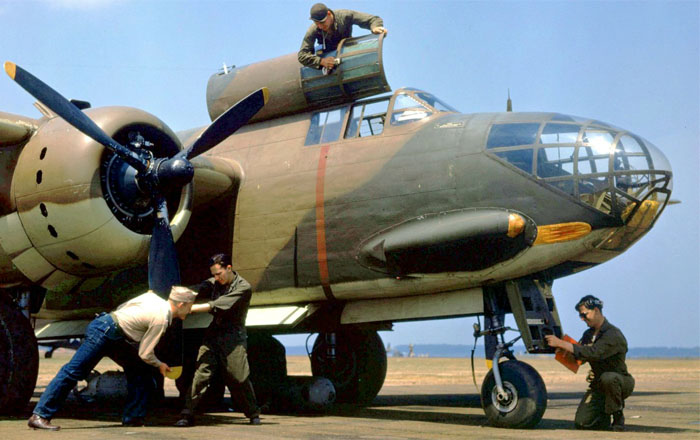
British MAP dark green was replaced with the darker and colder DuPont 71-013;
British MAP dark earth was replaced with the darker and less yellowish DuPont 71-035;
British MAP Sky was replaced with the lighter and more bluish DuPont 71-021.
It is possible that some planes delivered to the Soviet Union, already utilized in British service, were painted with the British MAP colors.
Aside we see some indicative digital chips trying to compare British shades (left) to U.S. shades (right).
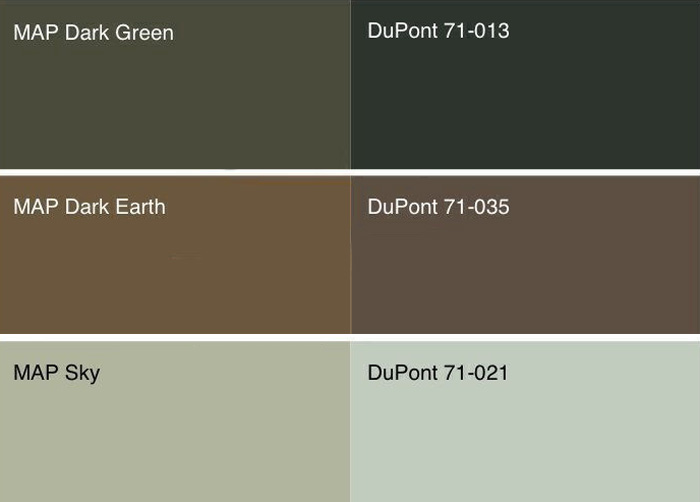
The camouflage was made by masks and was rigidly repetitive. Theoretically two specular pattern should exist, called A and B, but only the A pattern has been observed on photos of A-20s and Bostons.
The demarcation between the colors was only slightly blurred, nearly sharp.
Roundels of British planes were in six positions: over and below both wingtips and on the rear fuselage; besides, a three colors flag was painted on each side of the fin, and a black code of two letters and three digits was painted on the rear fuselage sides, close to the empennages.
A vertical red line was painted on the front fuselage sides to mark the rotation plan of the propeller blades.
Right: drawing of Tapani Tuomanen

The same camouflage was utilized on part of the planes that were from stocks built for Great Britain, retained in U.S. after their sudden ingress in the war and in service in USAAF (United States Army Air Forces).
The U.S. markings of 1941 consisted in a very dark blue disk with a white star with red round, but the red round was abandoned in 1942, just after the outbreak of the war against Japan. These stars were on four positions: on the fuselage sides, on the top of the left wing and under the right wing.
The shortened US serial (without the 4 in first position) was painted on the fin in yellow or in black.
Image from Squadron/Signal n. 144 'A-20 Havoc in action' of Jim Mesko
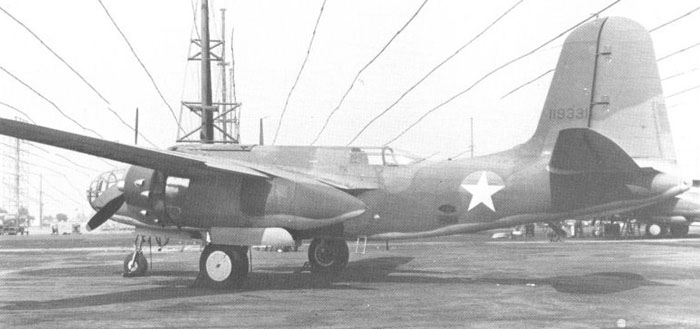
Planes from British stocks had their British or US marks deleted by British or American themselves with their own colors; the difference in shade between the camouflaged and repainted surface can be visible, anyway the colors were US or British ones. The red stars were painted on by British or Americans themselves on the size (about 1.5 m) of the deleted roundels and were, contrarily to the Soviet use, in the same six positions of the British roundels, including wing uppersurfaces. The British registration in black on the fuselage, or the U.S. registration in yellow or black on the fin, were preserved.
Below: local craftmanship of Abadan, Iran, is remarking an A-20 before the delivery to Soviet ferry crew in 1942 or early 1943.
Image from National Archives and Records Administration: Nara Reference Number: 342-FH-3A00886-25681AC.
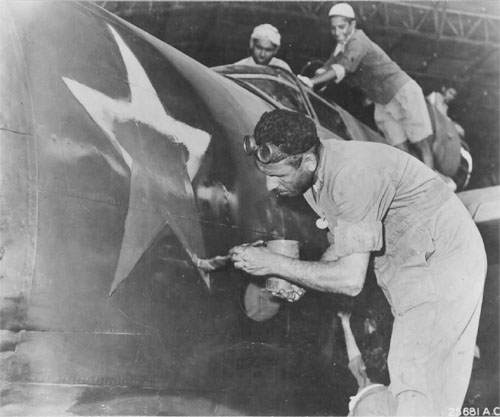
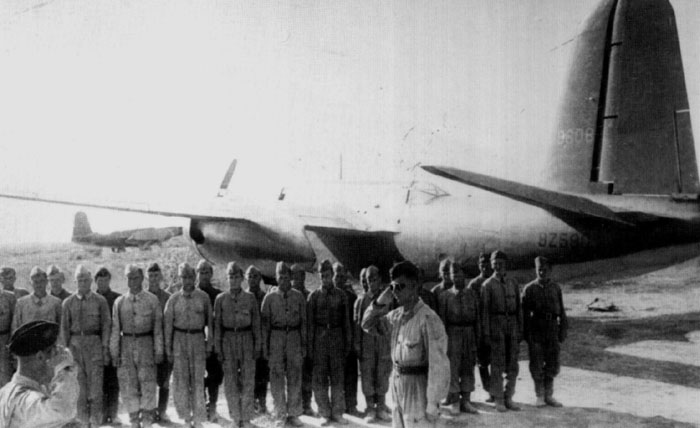
Above: ex-British Boston III and Soviet crew in training in Central Asia, August 1942. The plane is unusually carrying both the British code BZ590 in black on the fuselage and the U.S. number 119608 (A-20C-BO) on the tail, and has already received red stars with black outline on the fuselage and a number 5, probably red with a lighter outline, scarcely visible on its rudder.
Image from Red Stars 4, of Geust and Petrov, ed. Apali
The A-20 B that were not for stocks built for Great Britain were at first painted with dark olive drab 41 upper and side surfaces, and neutral grey 43 undersurfaces.
A regulation of April 1941 provided that blotches of medium green 42 'could' have been put on the contours of the wings and tail to break the shape of the plane. In this time, this was an option, and part of the planes received only olive drab on their upper and side surfaces.
The olive drab itself slightly changed its shade on different parts that were painted before being assembled; these differences, modest on new paint, could become stronger with ageing because the shade of the new paint was unified, but not its chemical composition, so paints of different producers aged in very different ways becoming more or less brownish, yellowish, grayish or greenish.
Again, a red line on the fuselage sides marked the proximity to the propeller's disk on each side. Red lines marked the walkable areas on the wing uppersurfaces. There was some stenciling, the most remarkable of which was a orange-red rectangle under the oval windows on the rear fuselage with the black inscription: 'Fire extinguisher'
Often a number of three digits was painted on the nose sides, with the same fonts and size of the code on the tail, to which it was related.
According to Aleksandrs Ruchkovskis, "Whenever you see an A-20B with 5digit tail serial starting with 12xxx and 13xxx, you detract 12670 and you get a nose number. It does not work this way at all with the A-20Cs that do have nose and tail serials as well but there is no regular link between them".
On this photo, we see a U.S. A-20B built in late 1941 or early 1942 with olive drab only upper finish.
Image from World War Photos

Right: A-20B from U.S. stocks has been already remarked in Abadan by American technicians. The difference in shade between the worn olive drab and the repainting is recognizable. The red star with black outline was put into six positions. The U.S. code was painted in yellow on the fin, and was usually left on the planes even in Soviet service because allowed to identify the plane.
Image from World War Photos

Right: drawing of typical A-20B supplied to the Soviet Union with the uppersufaces painted with nominally uniform Olive drab 41.
Repaintings on the insignias could have made with US paint, if made before the delivery, or with Soviet paints if made after.
Right: drawing of Tapani Tuomanen
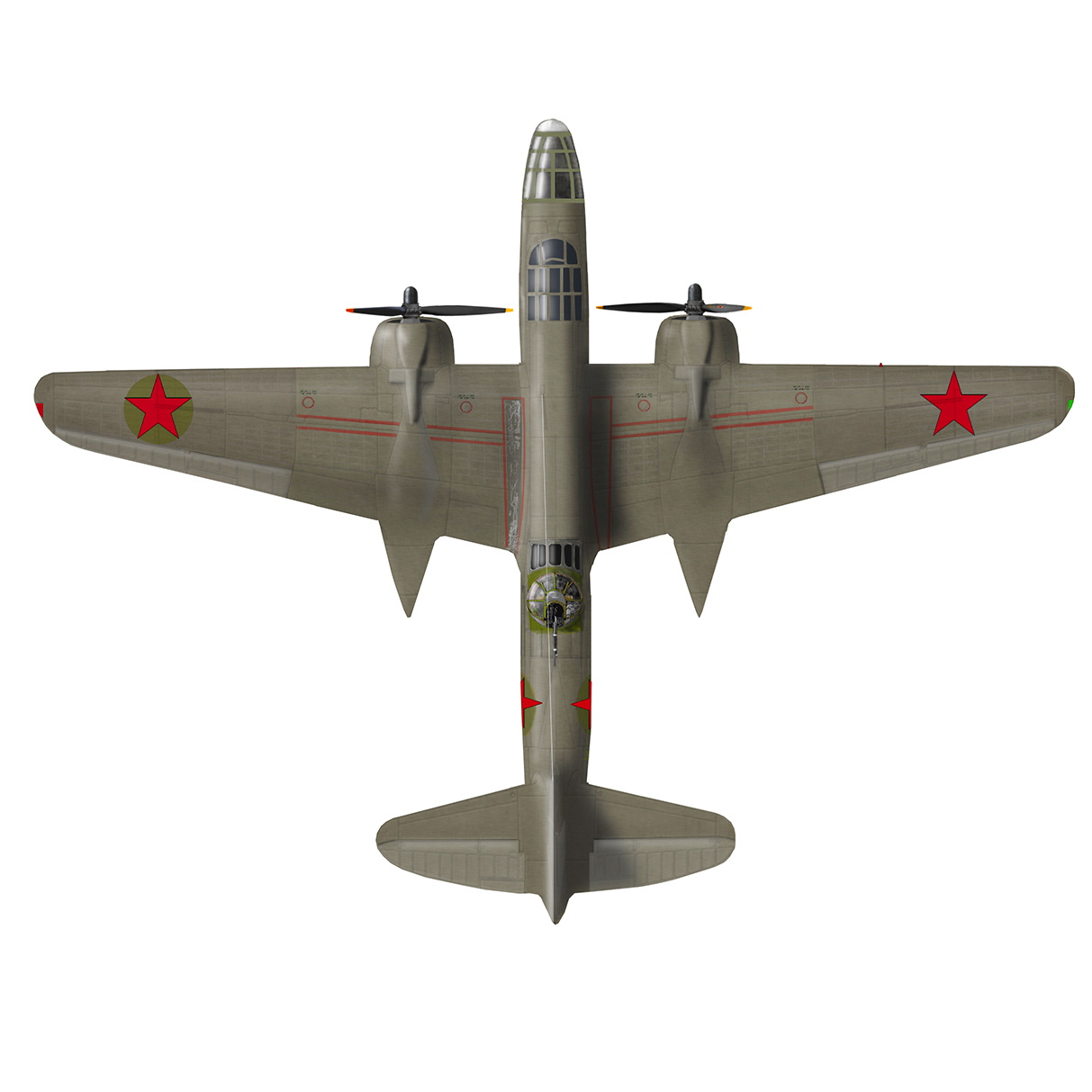
The use of medium green was provided in ambiguous terms in April 1941, and was made more clear in the revision of June 1942. Starting with late 1942, blotches of Medium green 42 were painted on the majority of A-20s supplied to Soviet Union.
On many planes, they were extended only on the contours of the wings and tail, no longer than 20% of the chord; many photos of A-20s show a more extensive use of the medium green 42, that became a sort of band camouflage covering areas on the fin, on the fuselage sides, nacelles and engine cowlings.
Medium green 42 was more or less similar to FS-34094; its successor ANA 612 (from September 1943) was similar but slightly lighter; on bw photos, they usually appear darker than the OD. These colors fade to a lighter shade, maintaining a well distinguishable green look. The medium green blotches were often discontinued on planes produced in 1945, but the production of A-20 ended in mid 1944, so all or nearly all A-20G, H, J, K had such blotches in some form, and can be supposed even in photos where they can't be clearly distinguished.
Image from World War Photos
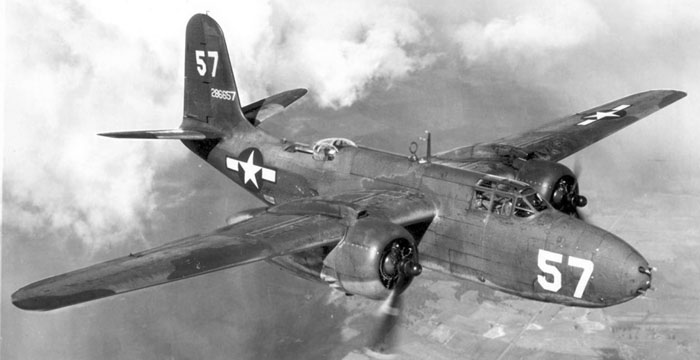
Olive drab41 (OD41) was introduced in 1941 as a standard paint for US planes at least up to late 1943. The color was similar to FS 33070 when new, and was not the same of the Army ground forces. In late 1943, the shades of OD of both Air Force and Ground Forces were unified into the ANA 613 Olive Drab, that was a bit lighter and more brownish than the shade of 1941, being similar to FS 34086, or better to RAL 7013 braungrau; according to many sources, anyway, the use of OD41 continued after that date.
Although brand new Olive Drab paint changed only slightly between the supplies of different producers, they were let free to use their own combination of pigments. In consequence of their choices, the paint changed in considerably different ways and amounts with the ageing; usually it became more or less lighter and could turn to brownish, yellowish, greenish or grayish shades in accordance to the most stable pigments of the chosen combinations. It can be that different parts of the same plane, painted with different stocks of OD paint before being assembled together, changed their shade in markedly different way with ageing. The fabric-skinned surfaces as rudder, ailerons and elevators turned quickly to a lighter and more grayish shade of OD.
Medium green 42 was similar to FS-34094; its successor ANA 612 (from September 1943) was similar but slightly lighter; on bw photos, they appear darker than the OD. These colors fade to a lighter shade, maintaining a well distinguishable green look. The medium green blotches were often discontinued on planes produced in 1945, but the production of A-20 ended in mid 1944, so all or nearly all had such blotches in some form, that can be supposed even in photos where they can't be clearly distinguished.
Neutral grey 43 was introduced in 1941 and was similar to FS 36134. In late 1943 it was replaced by the ANA 603 Sea grey, that was slightly darker and more blue-purple, similar to FS 36132.
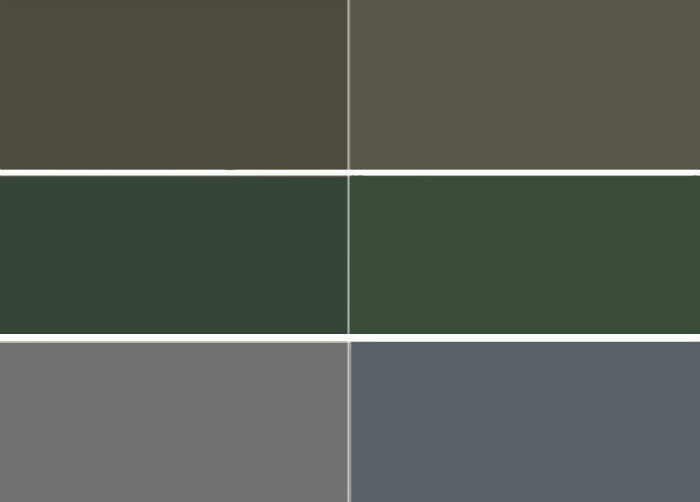
When A-20s with U.S. markings and camouflage were delivered to the Soviet Union, the U.S. marks could have been deleted with US colors, or the blue disks could have been left and then repainted with Soviet green A-24M or AMT-4. The red stars were overpainted to the white ones, but they were painted over and below both wings, even where there weren't U.S. markings, for a total of 6 positions. The size and position of the red stars usually matched the original white stars (where present).
White rectangle or bar was added on each side of the blue circle with a red border surrounding the entire insignia on June 29, 1943 and updated on Aug. 14, 1943 - red border was replaced with blue one. On planes remarked with Soviet insignias, this results visible in the shape and size of the olive drab or green repaintings to delete them.
When white or white-red outlines were added to the basic red stars, after August 1943, often these outlines protruded from the shape of the original U.S. insignia.
Right: drawing of Tapani Tuomanen
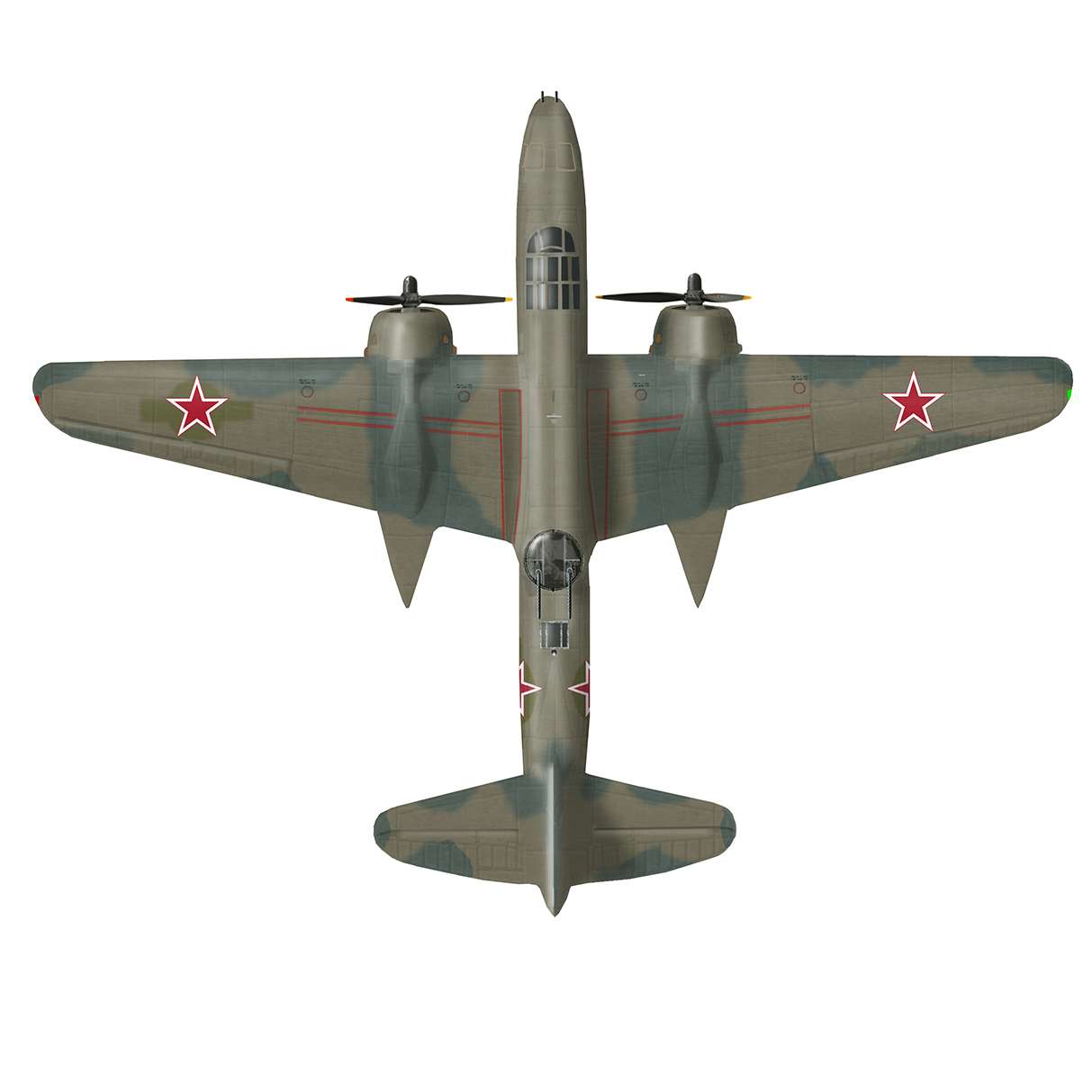
Part of Soviet A-20s received stars on the tail too, painted by Soviets, for a total of 8.
Here is a detail of an A-20B with the tail damaged by AA fire. Note that the plane was delivered in 1942, but has its red stars modified in the style after August 1943; so it should have had a relatively long life. The original defensive position was replaced with a UTK-1 turret. The emblem of the Guards is visible just behind the red star on the fuselage.
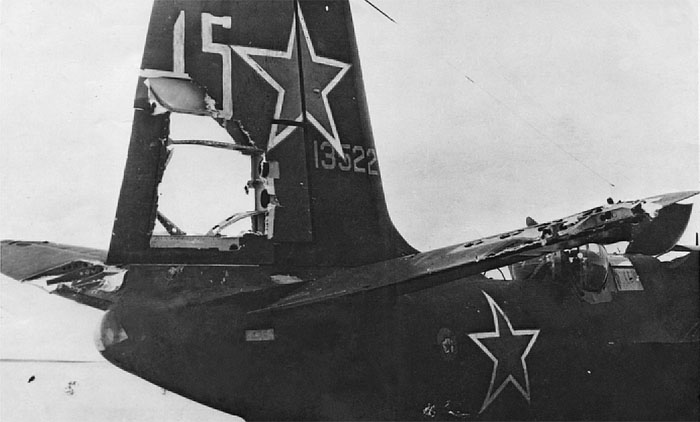
For some time in 1944, A-20s ferried to Soviet Union via the Alaska-Siberia route were marked by a red star on white disk by the Americans. This wasn't appreciated by Soviets, that repainted the white areas with their own green paint on upper and side surfaces, and added the white-red outline.
Under the wings, the deletion of the white areas could have been done either with green or light blue or perhaps some grey.
The color image puts into evidence the contrast between the olive drab and medium green, that is very marked in hue, but very uncertain on darkness; on bw photos, the medium green blotches usually appear darker than the olive drab, but they could also appear lighter, or of the same darkness and be unrecognizable.
Note the orange-red rectangle under the oval window on the rear fuselage, part of the usual stenciling of a-20s.
Image from World War Photos
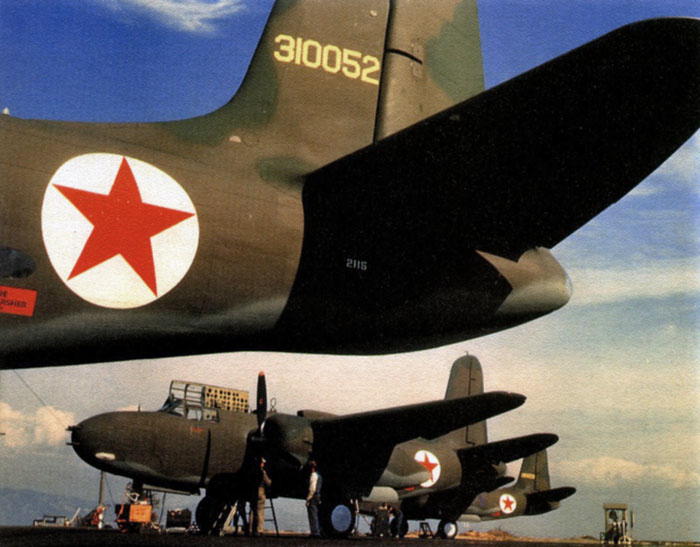
In Soviet service, the planes were sometimes modified, repaired and retouched with Soviet colors, particularly green (AMT-4 or A-24M), black or perhaps other colors.
Some disputable images show A-20s looking repainted with some rough attempt to match the standard green/dark grey/light brown camouflage of Soviet-built bombers of the period. The light areas visible over the nose could be the soviet A-21m light brown paint, while other repaintings seem black.
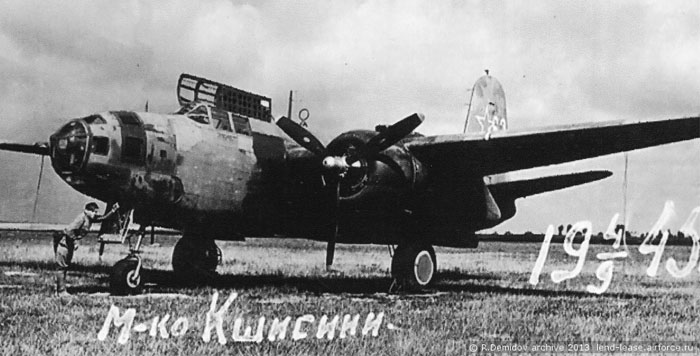
Towards or after the end of the war, some still serviceable lend-lease planes, including some A-20s, appear fully repainted with what could seem Soviet colors, perhaps solid A-24g green uppersurfaces and light blue A-28g undersurfaces. The darker color seems very dark on photos, and could also be fresh US olive drab ANA 613 or some imitation of it.
Image from Red Stars 4, of Geust and Petrov, ed. Apali
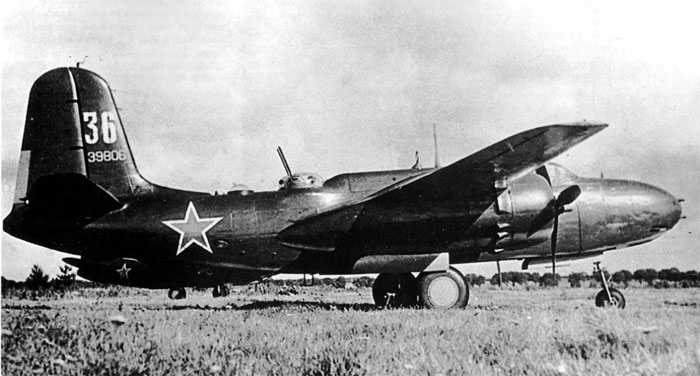
The only known archeological trace of this paint could be this wreck of C-47, that has a paint on the fuselage that, after 70 years, still seems a very dark grey.
Being only a partial repainting, it is likely that the look of the fresh paint wasn't too different than the original olive drab, that faded into a yellowish shade.
Image from https://edition.cnn.com/travel/article/douglas-c47-salvage-mission-siberia-russia/index.html
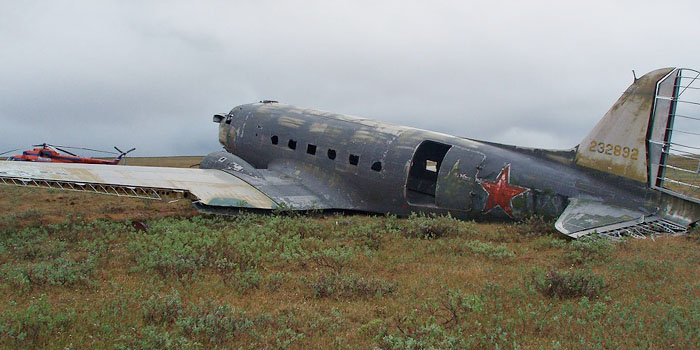
Some notes on the colors of interiors and other uncamouflaged parts.
The internal surfaces of Boston III and A-20A/B/C were painted, in general, with zinc chromate yellow-green (about FS-14255-14257).
This color was replaced by the slightly darker ANA 611 Interior green (about FS 34151) in 1943, that is more likely on A-20G/H/J/K (as photo aside)
Instrument panel and other equipments were painted in matt black.
The curtain inside the top of the canopy, sometimes visible, was dark cold green.
Pipelines were primed (except the copper made ones), and were marked with a band 12 mm wide, applied every 75 mm, with these colors:
- gasoline: red
- oil: yellow
- fire extinguishers: brown
- air: black.
The weapons appeared in gun metal black, including the armour plates of the machine guns.
Steel parts of the bomb racks were cadmium plated, fixed aluminum parts were primed.
The wheel legs and hubs appear in matt aluminum.
The prop blades were painted black with yellow tip (10 cm) on both faces; the hubs were either unpainted or painted black.
The engine crankcases were painted dark grey (Engine grey 22).

Image: wikimedia commons, USAAF museum